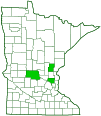brown and orange predatory stink bug
(Apoecilus cynicus)
Conservation • Description • Habitat • Ecology • Distribution • Taxonomy
|
|
||||||||||||||
Description |
Brown and orange predatory stink bug is the unimaginative common name for this large predatory stink bug. The species occurs in the United States and Canada. Based on the number of reported sightings, it is uncommon throughout its range, including in Minnesota. It is found on trees, shrubs, forbs, and grasses, mostly at woodland edges. It preys on caterpillars. Adults are ½″ to ¾″ (13 to 20 mm) in length. The body is broadly oval, and somewhat shield-shaped, appearing broad-shouldered. It is orangish-yellow or orange (pale) with light or heavy brown (dark) speckling. The sides of the head are nearly parallel. There are two large, bulging, compound eyes and two simple eyes (ocelli). The front of the head is divided into a central lobe (tylus) and two lateral lobes (juga). The juga are slightly longer than the tylus. The beak-like projection of the head (rostrum) is long, very thick, and has four segments. The first segment is thickened and free, enabling it to be swung fully forward. At the base of the rostrum there is a pair of raised plates (buccula). The bucculae are very short and cover only the base of the first segment of the rostrum. The antennae are pale and have five segments. The basal segment is very short, not reaching beyond the front of the head. The third segment is as long or almost as long as the fifth segment. All segments are densely covered with fine hairs. The thorax is twice as wide as long. The exoskeletal plate covering the thorax (pronotum) projects outward into an acute point in the shoulder (humeral) areas. There are two small black spots on each side just behind the head. The plate between the wing bases (scutellum) is large and broadly triangular at the base and has a U-shaped lobe at the tip. The lobe does not reach the tip of the abdomen. There are two pairs of wings, and they are held flat over the body when at rest. The forewings (hemelytra) are as long as the abdomen but do not completely cover the sides of the abdomen. The exposed sides are pale with six pairs of black spots. They appear conspicuously striped when the wings are closed. The hemelytra have a thickened, leathery section at the base and a thin membranous section at the tip with a clear dividing line between the two. The thickened basal part is comprised of a narrow area (clavus) behind the scutellum when the wings are closed, and the remaining broad marginal area (corium). The lobe at the apex of the scutellum is much narrower than the corium. The head, pronotum, scutellum, clavus, and corium are pale with dark speckling, and are coarsely and irregularly pitted (punctured). The hindwings are thin, membranous, and concealed under the forewings. The legs are pale. |
Size |
½″ to ¾″ (13 to 20 mm) in length |
Similar Species |
Habitat |
|
Ecology |
Season |
One generation per year: Early July to late September |
Behavior |
|
Life Cycle |
The female lays a mass of about 45 eggs in late Autumn. The eggs overwinter. Nymphs emerge the following year in mid-April to mid-May. |
Nymph Food |
Caterpillars |
Adult Food |
Caterpillars |
Distribution |
||
|
Sources |
|
| 11/3/2024 | ||
Occurrence |
||
|
||
Taxonomy |
|
Order |
Hemiptera (True bugs, Hoppers, Aphids, and Allies) |
Suborder |
Heteroptera (True Bugs) |
Infraorder |
Pentatomomorpha |
Superfamily |
Pentatomoidea (stink bugs, shield bugs, and allies) |
Family |
|
Subfamily |
Asopinae (predatory stink bugs) |
Genus |
Apoecilus |
Subordinate Taxa |
|
|
|
Synonyms |
|
Apateticus cynicus |
|
Common Names |
|
brown and orange predatory stink bug |
|
Glossary
Corium
The thickened basal portion of the front wing that lies between the clavus and the membrane of insects in the family Hemiptera. Plural: coria.
Hemelytron
The forewing of true bugs (order Hemiptera), thickened at the base and membranous at the tip. Plural: hemelytra.
Ocellus
Simple eye; an eye with a single lens. Plural: ocelli.
Pronotum
The exoskeletal plate on the upper side of the first segment of the thorax of an insect.
Rostrum
The stiff, beak-like projection of the carapace or prolongation of the head of an insect, crustacean, or cetacean.
Scutellum
The exoskeletal plate covering the rearward (posterior) part of the middle segment of the thorax in some insects. In Coleoptera, Hemiptera, and Homoptera, the dorsal, often triangular plate behind the pronotum and between the bases of the front wings. In Diptera, the exoskeletal plate between the abdomen and the thorax.
Visitor Photos |
||
Share your photo of this insect. |
||
This button not working for you? |
||
Alfredo Colon |
||
 |
 |
|
 |
 |
|
 |
||
Molly and Robert Power |
 |
MinnesotaSeasons.com Photos |
||
|
||
|
||

Slideshows |
|

Visitor Videos |
||
Share your video of this insect. |
||
This button not working for you? |
||
|
Other Videos |
||
|

Created: 7/26/2022 Last Updated: © MinnesotaSeasons.com. All rights reserved. |


